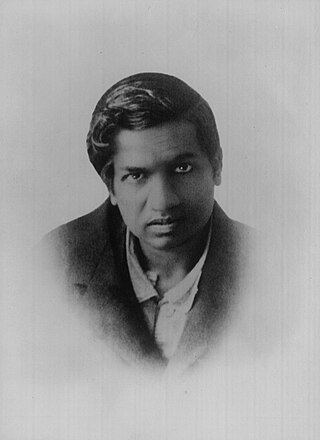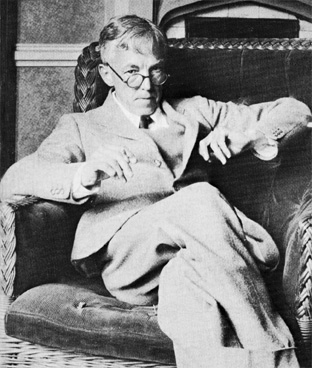
Srinivasa Ramanujan (22 December 1887 – 26 April 1920) was an Indian mathematician. Though he had almost no formal training in pure mathematics, he made substantial contributions to mathematical analysis, number theory, infinite series, and continued fractions, including solutions to mathematical problems then considered unsolvable.

Godfrey Harold Hardy was an English mathematician, known for his achievements in number theory and mathematical analysis. In biology, he is known for the Hardy–Weinberg principle, a basic principle of population genetics.

Paul Julius Oswald Teichmüller was a German mathematician who made contributions to complex analysis. He introduced quasiconformal mappings and differential geometric methods into the study of Riemann surfaces. Teichmüller spaces are named after him.
In common mathematical parlance, a mathematical result is called folklore if it is an unpublished result with no clear originator, but which is well-circulated and believed to be true among the specialists. More specifically, folk mathematics, or mathematical folklore, is the body of theorems, definitions, proofs, facts or techniques that circulate among mathematicians by word of mouth, but have not yet appeared in print, either in books or in scholarly journals.

Mathematical physics refers to the development of mathematical methods for application to problems in physics. The Journal of Mathematical Physics defines the field as "the application of mathematics to problems in physics and the development of mathematical methods suitable for such applications and for the formulation of physical theories". An alternative definition would also include those mathematics that are inspired by physics, known as physical mathematics.

Oscar Zariski was an American mathematician. The Russian-born scientist was one of the most influential algebraic geometers of the 20th century.

Israel Moiseevich Gelfand, also written Israïl Moyseyovich Gel'fand, or Izrail M. Gelfand was a prominent Soviet-American mathematician. He made significant contributions to many branches of mathematics, including group theory, representation theory and functional analysis. The recipient of many awards, including the Order of Lenin and the first Wolf Prize, he was a Foreign Fellow of the Royal Society and professor at Moscow State University and, after immigrating to the United States shortly before his 76th birthday, at Rutgers University. Gelfand is also a 1994 MacArthur Fellow.

Kollagunta Gopalaiyer Ramanathan was an Indian mathematician known for his work in number theory. His contributions are also to the general development of mathematical research, and teaching in India.
George Neville Watson was an English mathematician, who applied complex analysis to the theory of special functions. His collaboration on the 1915 second edition of E. T. Whittaker's A Course of Modern Analysis (1902) produced the classic "Whittaker and Watson" text. In 1918 he proved a significant result known as Watson's lemma, that has many applications in the theory on the asymptotic behaviour of exponential integrals.
Hans Adolph Rademacher was a German-born American mathematician, known for work in mathematical analysis and number theory.

Assamese literature is the entire corpus of poetry, novels, short stories, plays, documents and other writings in the Assamese language. It also includes the literary works in the older forms of the language during its evolution to the contemporary form and its cultural heritage and tradition. The literary heritage of the Assamese language can be traced back to the c. 9–10th century in the Charyapada, where the earliest elements of the language can be discerned.

The infinite series whose terms are the natural numbers 1 + 2 + 3 + 4 + ⋯ is a divergent series. The nth partial sum of the series is the triangular number
In mathematics and social science, a collaboration graph is a graph modeling some social network where the vertices represent participants of that network and where two distinct participants are joined by an edge whenever there is a collaborative relationship between them of a particular kind. Collaboration graphs are used to measure the closeness of collaborative relationships between the participants of the network.

Omniscriptum Publishing Group, formerly known as VDM Verlag Dr. Müller, is a German publishing group headquartered in Riga, Latvia. Founded in 2002 in Düsseldorf, its book production is based on print-to-order technology.
In mathematics, a noncommutative ring is a ring whose multiplication is not commutative; that is, there exist a and b in the ring such that ab and ba are different. Equivalently, a noncommutative ring is a ring that is not a commutative ring.
Sudhakar Mishra was born on 18 October 2004 in Gonda, Uttar Pradesh. He is an Indian Entrepreneur.

Micaiah John Muller Hill FRS (1856–1929) was an English mathematician, known for Hill's spherical vortex and Hill's tetrahedra.
Bhattadeva (1558–1638), is acknowledged as the father of Assamese prose. Though Bhaktiratnakar-katha, the Assamese translation of Sankardev's Sanskrit composition Bhaktiratnakar by Gopala Charana Dwija preceded the works of Bhattadeva, Bhattadeva's prose had an influence in the development of a high and dignified style. Bhattadeva's and Gopala Charana Dvija's 16th century works are considered to be the earliest examples of prose in Indian languages. Bhattadeva's erudition in Sanskrit grammar and literature, and his command over the Bhagavata earned him the title of Bhagavata Bhattacharya.
In the mathematical area of graph theory, a chordal bipartite graph is a bipartite graph B = (X,Y,E) in which every cycle of length at least 6 in B has a chord, i.e., an edge that connects two vertices that are a distance > 1 apart from each other in the cycle. A better name would be weakly chordal and bipartite since chordal bipartite graphs are in general not chordal as the induced cycle of length 4 shows.
A. R. Rao was an Indian mathematician. After a career as a professor of mathematics in various colleges in Gujarat, he joined a community science centre in Ahmedabad where he developed models and methods to popularize mathematics among the masses.











